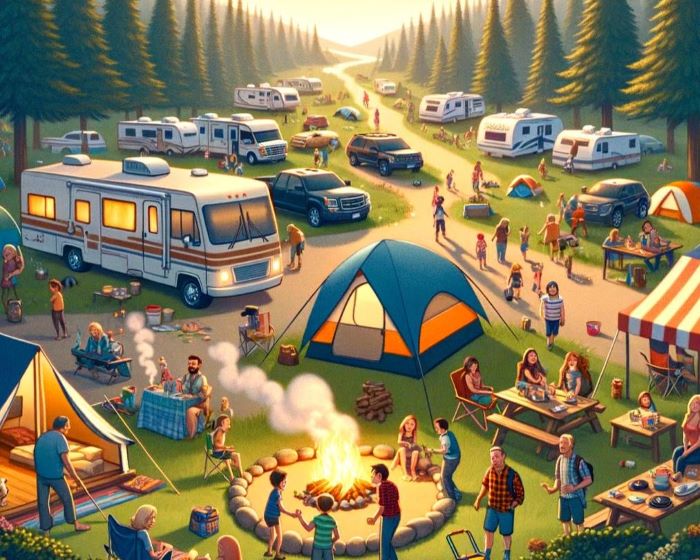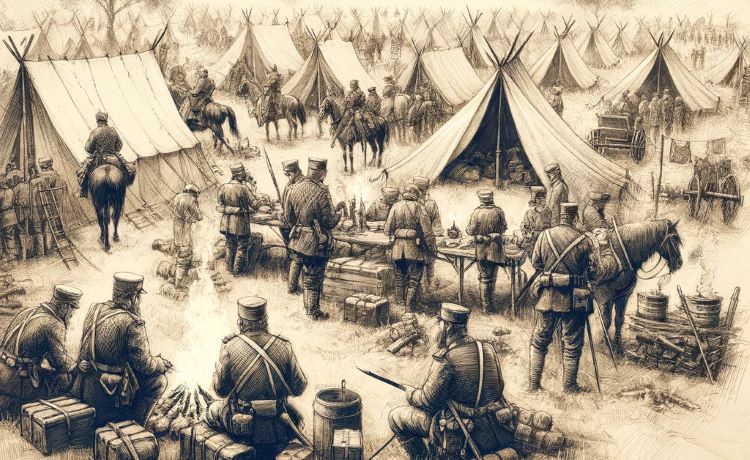This is the biggest list of camping terminology on the planet (probably).
For people new to camping, there can be a steep learning curve to all the jargon and terms used in camping. There are a lot of words to learn, and without any point of reference, you start looking them up.
Most lists barely touch on the subject with a top 10 or 20 terms used in camping, so you end up yo-yo-ing between sites to find the answers you are looking for. But don’t worry, I got you covered.
I took the trouble to go over all the camping terms I could find and curate the scattered information on this page. In one single list.
Table of contents
- Hammock Camping Terminology
- Tent Camping Terminology
- Hiking Terminology
- Backpacking Terminology
- Car Camping Terminology
- RV/Van Camping Terminology
- Bikepacking/Bicycle Touring Camping Terminology
- Survival Camping Terminology
- Ultralight Camping Terminology
- Glamping/Glam Camping Terminology
- Overlanding Terminology
- Backyard Camping Terminology
- Winter Camping Terminology
- Tarp Camping Terminology
- Bivvy Sack Terminology
- Lazy Camping Terminology
- Canoe/Kayak Camping Terminology
- Primitive Camping Terminology
- Dispersed Camping Terminology
- Motorcycle Camping Terminology
- Cabin Camping Terminology
- General Camping Terminology
- Conclusion
With this glossary of camping terms and terminology, you can soon head out into nature armed with the right knowledge. Use it as your personal camping dictionary, or camping vocabulary, if you will.
Here on Happy Hammock Camper, I talk a lot about hammock camping, so let’s dive right in starting with just that.
Hammock Camping Terminology
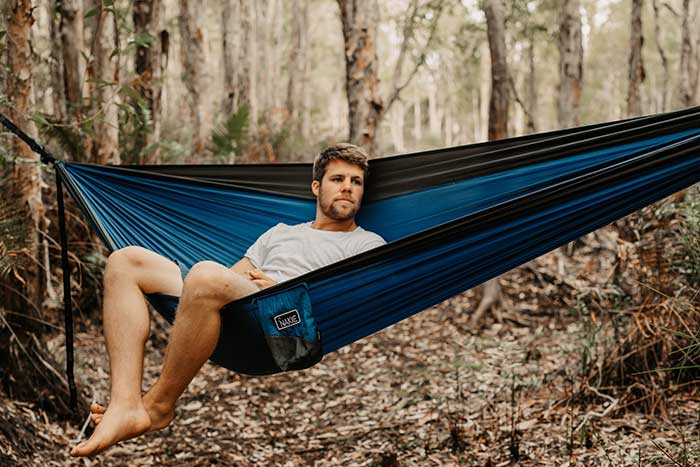
- Amsteel: Strong, low-stretch synthetic rope used in hammock suspension and accessories.
- Anchor Points: The trees, posts, or structures to which the hammock’s suspension system is attached, providing secure support for the hammock.
- Banana Hammock: A term sometimes humorously used to refer to a hammock due to its curved shape resembling that of a banana.
- Bridge Hammock: A hammock with a flat, bed-like design achieved by spreader bars, offering unique comfort and support.
- Bug Net: A mesh enclosure surrounding a hammock, protecting campers from insects and mosquitos, and enhancing sleep quality.
- Camping Hammock: A strong piece of fabric made from specialized materials like ripstop nylon, suspended between two anchor points (like a couple of trees); elevated camping bed.
- Carabiner: A metal loop with a spring-loaded gate, used for connecting components in a hammock’s suspension system.
- Drip Line: A line or string, tied to suspension or tarp line to deflect and avoid water entry.
- Dyneema Straps: Lightweight, strong straps made from Dyneema fiber, used to suspend hammocks and minimize impact on trees.
- End Channels: Fabric tunnels on the sides of hammocks through which suspension cords are threaded, preventing them from shifting and enhancing stability.
- Finger Traps: A method of attaching webbing to itself to create a secure and adjustable loop for hanging a hammock.
- Gear Sling: A small hammock or pouch hung beneath the main hammock for storing gear, water bottles, or shoes.
- Hammock Stand: A portable frame designed to support hammocks, enabling hammock camping in areas with limited trees.
- Insect Shield: Hammocks treated with insect-repellent chemicals to deter bugs and provide an added layer of protection.
- Integrated Bug Net: A bug net that is permanently attached to a hammock, providing continuous protection against insects.
- Jungle Hammock: A type of hammock with an integrated mosquito net and rainfly, suitable for tropical environments.
- Knotless Suspension: A suspension system that uses hardware like carabiners and toggles, eliminating the need for knots and facilitating quick setup.
- Lay: Refers to the position and comfort of the hammock while lying in it; terms like “banana lay” or “flat lay” describe the curve or straightness of the hammock.
- Mesh Pocket: A small pouch attached to the interior of a hammock for storing personal items like a headlamp or phone.
- Napoleon Pocket: A storage pocket located on the ridgeline of a hammock for easy access to small essentials.
- Overcover: A secondary layer that can be added to a hammock to provide additional insulation and weather protection.
- Pillow Pocket: A built-in or attachable pocket on a hammock designed to hold a camp pillow for added comfort.
- Quilt Hooks: Attachments on the sides of a hammock to secure an underquilt and prevent it from shifting during sleep.
- Rainfly: A protective tarp positioned above a hammock to shield from rain and wind.
- Ridgeline Organizer: An accessory that hangs on the ridgeline of a hammock, providing compartments for storing items like glasses, a book, or a phone.
- Sling Strap: A type of suspension strap, commonly used in lightweight hammock setups.
- Structural Ridgeline: A cord that runs between the anchor points of a hammock, maintaining a consistent hang angle and shape for optimal comfort.
- Tarp: A versatile, water-resistant, or waterproof sheet typically made of materials like polyester, nylon, silnylon, silpoly, or Dyneema. Used in camping, a tarp functions as a lightweight, protective shelter. It can be draped over hammocks, tents, or used as a standalone rainfly, providing defense against rain, wind, and sun, ensuring a comfortable and dry campsite.
- Tree-Friendly Straps: Wide straps designed to distribute weight and minimize damage to tree bark when hanging a hammock.
- Tree Huggers: Wide straps protecting trees and distributing weight during hammock setup.
- Ultralight Hammock: A lightweight and compact hammock designed for minimalist backpacking.
- Underpad: An insulating layer placed beneath a hammock sleeper to provide warmth and protection from cold air.
- Underquilt: Insulated layer beneath a hammock, providing warmth and comfort in colder conditions.
- Vapor Barrier Liner: A waterproof layer placed inside a hammock to prevent moisture from penetrating the hammock’s insulation.
- Whoopie Sling: Adjustable suspension cords with a loop-and-knot design, allowing quick changes in hammock tension.
Tent Camping Terminology
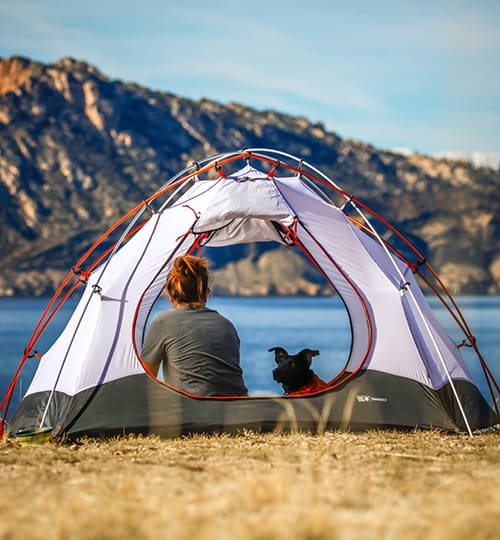
- A-Frame Tent: A traditional tent design featuring a pitched-roof shape resembling the letter “A,” providing simplicity, ease of setup, and efficient rain runoff.
- Bathtub Floor: A tent floor design featuring raised edges that prevent water infiltration during rainy conditions, keeping the interior dry and comfortable.
- Catenary Cut: A method of shaping tent guylines in a slight curve to minimize tension and enhance stability, particularly useful in windy conditions.
- Condensation: The accumulation of moisture inside a tent due to temperature differences between the interior and exterior, often managed with proper ventilation.
- Dome Tent: A freestanding tent characterized by its dome-shaped frame, offering a balanced combination of interior space and wind resistance, suitable for various terrains.
- Footprint: A protective ground cloth placed beneath the tent to shield the floor from abrasions, moisture, and potential damage, extending the tent’s lifespan.
- Ground Sheet: A protective layer placed beneath a tent to shield it from moisture, rocks, and debris, enhancing durability. Also prevents heat loss through an added layer.
- Guyline: A cord attached to tent corners and rainfly edges, used to anchor and stabilize the tent, especially in adverse weather conditions.
- Hub System: A tent pole junction utilizing a central hub, simplifying setup by allowing multiple poles to connect at a single point, streamlining assembly.
- Inner Tent: The enclosed section of a tent providing privacy, insulation, and a barrier against condensation, ensuring a comfortable sleeping environment.
- Jakes Foot: A specialized tent stake designed with a hook, enabling secure attachment of guylines to the stake for enhanced stability.
- Lantern Loop: An attachment point within the tent for hanging a lantern, providing interior illumination and a cozy atmosphere.
- Mesh Panel: Ventilated sections within the tent walls equipped with fine mesh fabric, promoting airflow and reducing condensation buildup.
- Noseeum Mesh: Fine mesh material with a tight weave, preventing entry of small insects like noseeums while maintaining optimal airflow.
- Oversized Vestibule: A spacious covered area located outside the tent’s entrance, offering ample storage space for gear and providing weather protection.
- Peak Height: The highest point inside the tent, indicating vertical space available for comfortable movement and changing clothes.
- Pop-Up Tent: A type of tent designed for quick and easy setup, featuring pre-attached poles that “pop up” into shape when unfolded.
- Quilt Hooks: Attachments within the tent designed for securing a sleeping bag or quilt, preventing shifting during sleep for consistent warmth.
- Seam Sealing: The process of applying a waterproof sealant to tent seams, preventing water infiltration and ensuring a dry interior during rain.
- Tent Poles: Structural components used to create the framework of a tent, providing support and shape to the shelter.
- Tent Stakes: Pegs inserted into the ground to secure the tent, preventing movement and enhancing stability, particularly in windy environments.
- Ultralight Tent: A lightweight and compact tent designed for minimalist backpacking, prioritizing weight savings while providing essential shelter.
- Ventilation: Strategic openings, vents, and mesh panels in a tent design that promote airflow and minimize condensation.
- Vestibule: A covered area outside the tent’s door, offering space for gear storage, cooking, and additional protection from the elements.
- Wall Pockets: Interior pouches integrated into tent walls for organizing and stowing small essentials like glasses, phones, or maps.
- X-Pole Design: A tent pole configuration forming an X shape, contributing to tent stability and maximizing headroom within the shelter.
- Zipper Garage: A fabric cover located at the end of a zipper to prevent snags, enhance weather resistance, and ensure smooth operation.
- Zipper Pulls: Attachments added to zipper sliders for easy gripping and manipulation, especially with gloves or cold hands.
Hiking Terminology
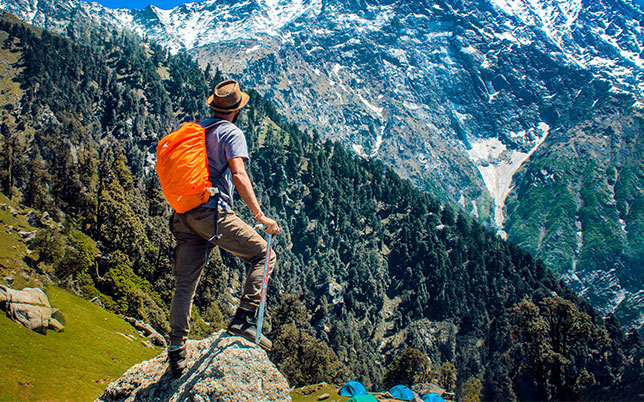
- AllTrails: A popular app and website offering a comprehensive database of hiking trails, reviews, and trail maps.
- Base Weight: The total weight of a backpack without food, water, or fuel, often used as a measure of a hiker’s gear efficiency.
- Cairn: A stack of rocks used as a trail marker to indicate the correct path, especially in areas with unclear or challenging terrain.
- Elevation Gain: The total vertical distance hiked uphill on a trail, a key factor in gauging the trail’s difficulty.
- FKT (Fastest Known Time): The quickest recorded time for completing a specific hiking trail, route, or challenge.
- Gaiters: Protective coverings worn over hiking boots and pants to keep debris, snow, and water out.
- Hiking Poles: Lightweight, collapsible poles used for stability, balance, and reducing strain while hiking.
- InReach: A satellite communication device that enables hikers to send messages and request help in remote areas.
- Jetboil: A popular brand of portable stove systems used by hikers to cook meals and boil water.
- Katahdin: Refers to Mount Katahdin in Maine, often the northern terminus of the Appalachian Trail.
- Microspikes: Traction devices worn over hiking boots for added grip on icy or snowy terrain.
- Navigation: The skill of using maps, compasses, GPS devices, and landmarks to find one’s way on a trail.
- Out-and-Back: A type of hike where the trail is followed to a destination and then retraced back to the starting point.
- Peak Bagging: The pursuit of summiting a specific number or collection of mountain peaks.
- Quandary Peak: A notable 14,000-foot peak located in Colorado, popular among hikers and climbers.
- Rim-to-Rim: A challenging hike crossing the Grand Canyon from one rim to the other.
- Switchbacks: Zigzagging trail sections that help hikers ascend steep terrain in a less direct manner.
- Thru-Hike: Completing an entire long-distance trail from start to finish in a single continuous journey.
- Ultralight Hiking: A philosophy and approach to hiking that emphasizes carrying minimal gear for reduced pack weight.
- Wayfinding: Using natural cues, landmarks, and environmental features for navigation without relying on maps or technology.
- Yaktrax: Traction devices worn over hiking boots to improve grip on icy or snowy surfaces.
- Zero Day: A day when a hiker covers zero trail miles, often used for rest, recovery, or resupply.
- AT (Appalachian Trail): A legendary long-distance trail stretching over 2,000 miles along the eastern United States.
- Cairn Aisle: A line of cairns marking a route, common in areas with sparse vegetation or rocky terrain.
- Day Hike: A hike completed in one day, typically covering shorter distances and returning to the starting point.
- Elevation Profile: A graph displaying changes in elevation along a hiking trail, helping hikers anticipate terrain challenges.
- Fire Tower: A tower built on a mountain summit, offering panoramic views and often serving as a hiking destination.
- GPS Tracking: Using a Global Positioning System device to track and record a hiker’s route and location.
- Hiker’s High: The feeling of euphoria and mental clarity often experienced during or after a long hike.
- Incline: The upward slope of a trail or section of trail, influencing the effort required for hiking.
- Knife Edge: A narrow, exposed trail section with steep drops on either side, requiring careful navigation.
- Orienteering: Navigating using a map and compass to find specific points or complete a course.
- PCT (Pacific Crest Trail): A long-distance trail spanning over 2,600 miles along the western United States.
- Quick-Drying: Describes clothing and gear that dries rapidly, important for staying comfortable in wet conditions.
- Scrambling: A mix of hiking and climbing, involving the use of hands to ascend rocky terrain.
- Trail Magic: This can include finding what you need the most, when unexpected, experiencing something rare or inspiring in nature, or unexpected acts of generosity.
- Trail Register: A logbook often found at trailheads or shelters where hikers can sign in and leave messages.
- Umbrella: A portable, lightweight umbrella used by some hikers to provide shade or rain protection.
- Waymarking: Placing markers, blazes, or signs along a trail to indicate the correct route.
- Xenophobe: An irrational fear of the unknown or unfamiliar, sometimes experienced by hikers exploring new areas.
- Yosemite Decimal System (YDS): A numerical scale used to rate the difficulty of hiking and climbing routes.
Backpacking Terminology
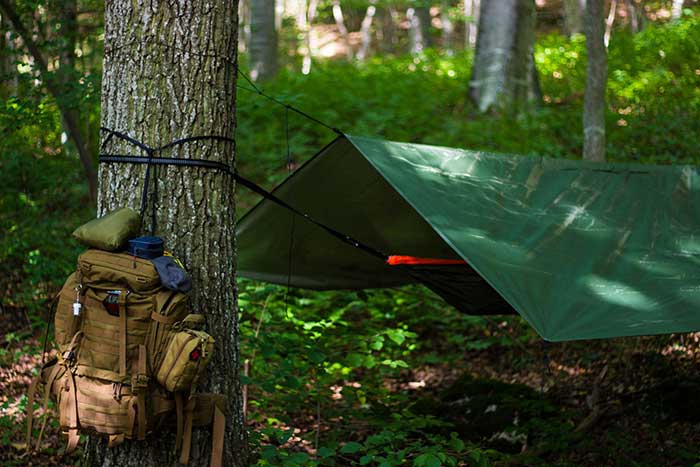
- Alpine Start: Beginning a hike before sunrise to cover significant mileage or challenging terrain.
- Cuben Fiber: A lightweight, durable, and waterproof material used for backpacks, shelters, and gear.
- Dry Bag: A waterproof bag used to protect sensitive gear and clothing from moisture.
- Expedition Pack: A large backpack designed to carry heavy loads on extended wilderness trips.
- Hydration Bladder: A water reservoir that fits inside a backpack, allowing easy access to water while hiking.
- Internal Frame Pack: A backpack with an internal frame that conforms to the body for improved balance and comfort.
- JMT (John Muir Trail): A scenic long-distance trail spanning over 200 miles through the Sierra Nevada mountains.
- Lash Points: Attachments on a backpack for securing gear, such as trekking poles or ice axes.
- Mummy Bag: A type of sleeping bag with a tapered design to minimize weight and maximize warmth.
- Osprey Packs: A type of backpack made from a durable and waterproof fabric, suitable for challenging conditions.
- Poncho Tarp: A versatile piece of gear that functions as both a rain poncho and a shelter tarp.
- Quick-Release Buckle: A type of buckle used in backpacks and gear for secure fastening and easy release.
- Rucksack: A military-style backpack often characterized by its top-loading design and durable materials.
- Ultralight Backpacking: A philosophy and approach to backpacking that emphasizes carrying minimal gear for reduced pack weight.
- Wicking Fabric: Clothing materials designed to pull moisture away from the body, keeping backpackers dry and comfortable.
Car Camping Terminology
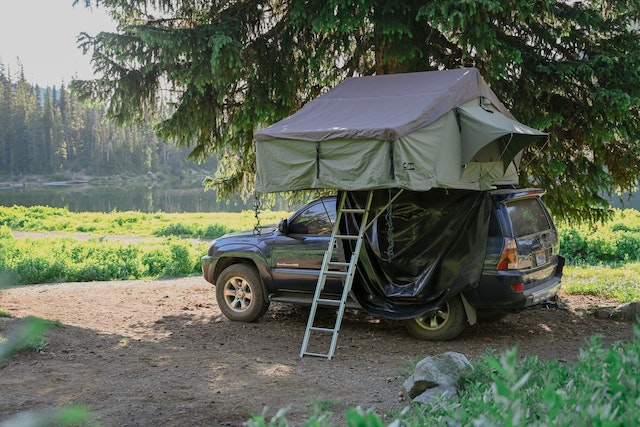
- Awning: A portable shelter that attaches to a vehicle, providing shade and protection from the elements.
- Collapsible Table: A foldable table that can be easily transported and set up at a campsite.
- Cooler: An insulated container used to keep food and beverages cold.
- Dutch Oven: A heavy, cast-iron pot with a lid, often used for cooking meals over an open fire.
- Extension Cord: A long power cord used to connect electronic devices to a power source at a campsite.
- Inverter: An electronic device that converts DC power from a car battery into AC power for charging electronics.
- Jug Water/Camping Water Container: Water stored in large containers, often used for drinking, cooking, and cleaning.
- Kitchen Box: A container or organizer that holds cooking utensils, cutlery, and other kitchen essentials.
- Lantern: A portable light source used to illuminate a campsite at night.
- Mosquito Net: Fine mesh fabric used to create a barrier against insects while sleeping or relaxing.
- Naptha Stove: A type of portable stove that burns liquid fuel, commonly used for cooking in outdoor settings.
- Portable Grill: A compact cooking surface used for grilling food over an open flame or campfire.
- Quiet Hours: Designated times during which campers are expected to keep noise levels to a minimum.
- Roof Rack: A framework installed on the roof of a vehicle to carry gear, such as bicycles, kayaks, or luggage.
- Solar Charger: A device that uses sunlight to generate power for charging electronic devices.
- Trash Bags: Disposable bags used to collect and contain trash and waste at the campsite.
RV/Van Camping Terminology

- Black Water Tank: A holding tank for wastewater from toilets in RVs, typically requiring regular emptying at designated dump stations.
- Boondocking: Camping without hookups or facilities, often in remote or off-grid locations.
- Class A Motorhome: A large, bus-like RV with extensive amenities, suitable for long trips and full-time living.
- Dump Station: A facility where RVers can empty their waste tanks and refill fresh water supplies.
- Fifth Wheel Trailer: A type of towable RV that is hitched to a pickup truck using a special fifth-wheel hitch.
- Full Hookup: A campsite with access to water, electric, and sewer connections for RVs.
- Grey Water: Wastewater generated from sinks, showers, and other non-toilet sources in an RV.
- Hitch: A device used to connect a trailer to a tow vehicle, such as a receiver hitch or fifth-wheel hitch.
- Jacks: Mechanisms used to stabilize and level an RV when parked.
- KOA (Kampgrounds of America): A popular chain of campgrounds offering facilities and amenities for RVers.
- LPG (Liquefied Petroleum Gas): Propane used for cooking, heating, and powering appliances in RVs.
- Motorhome: A general term for a self-contained RV with living quarters and amenities.
- Pull-Through Site: A campsite designed for easy access, allowing RVs to drive straight through without backing up.
- RV Park: A campground specifically designed to accommodate RVs, offering various amenities and hookups.
- Slide-Out: A retractable section of an RV that expands to create additional living space.
- Toad: A slang term for a vehicle towed behind an RV, often used for sightseeing and transportation.
- Utility Hookups: Connections for water, electric, and sewer services at RV campsites.
- Waste Valve: A valve used to control the release of wastewater from RV holding tanks.
Bikepacking/Bicycle Touring Camping Terminology

- Bikepacking: Combining cycling with lightweight camping, often on off-road trails and routes.
- Cyclocross Bike: A versatile bicycle designed for a combination of road and off-road cycling.
- Drop Bars: Handlebars that curve downward, providing multiple hand positions for comfort and control.
- Elevation Gain: The total vertical distance gained in elevation during a bikepacking route.
- Fat Bike: A bicycle with wide tires designed for riding on soft or loose terrain, such as sand or snow.
- Gravel Bike: A bike designed for mixed-terrain riding, combining elements of road and mountain biking.
- Handlebar Bag: A bag that attaches to the handlebars, used for carrying lightweight gear and supplies.
- Inner Tube: A replaceable rubber tube that holds air in a bike tire.
- Journey: A bikepacking trip or tour.
- Kickstand: A small stand that props up a bicycle when stationary.
- Lycra: A stretchy material often used in cycling clothing for comfort and aerodynamics.
- Multi-Day Touring: Cycling over multiple days, often covering long distances and camping along the way.
- N+1: A humorous term referring to the ideal number of bicycles one should own, where “N” is the current number.
- On-Bike Storage: Bags and accessories designed to carry gear on the bicycle itself.
- Panniers: Bags that attach to racks on the front or rear of a bicycle, used for carrying gear.
- Quick-Release: A mechanism that allows for fast and easy removal of wheels and other components.
- Rim Brakes: Braking systems that apply pressure to the wheel’s rims to slow down or stop the bike.
- Saddle Bag: A bag that attaches to the underside of the bicycle saddle, used for carrying small items.
- Tubeless Tires: Tires that don’t require inner tubes, offering lower rolling resistance and reduced risk of flats.
- U-Lock: A type of bicycle lock shaped like the letter “U,” often used for securing the frame and wheel to a fixed object.
Survival Camping Terminology
/image
- Bushcraft: Wilderness survival skills and techniques, including fire-making, shelter-building, and foraging.
- Cordage: Strong, durable string or rope made from natural materials, used for various tasks.
- Dehydrated Food: Food that has been dried to remove moisture, making it lightweight and suitable for storage.
- Emergency Shelter: A temporary shelter, often compact and lightweight, used for protection in survival situations.
- Fire Starter: A tool or material used to ignite a fire, such as matches, lighters, or fire steel. Also natural fire starters such as a bow drill.
- Gill Net: A type of fishing net used to catch fish by entangling them in its mesh.
- Hobo Stove: An improvised cooking stove made from a metal container, often fueled by wood or other combustibles.
- Improvised Weapon: A tool or object repurposed for self-defense in survival situations.
- Knife Skills: Proficiency in using knives for various tasks, including food preparation and crafting.
- Mylar Blanket: A lightweight, reflective blanket used to retain body heat and provide shelter.
- Paracord: A lightweight, strong cord made of nylon, often used for various survival applications.
- Quinzee: A type of snow shelter made by hollowing out a mound of snow and allowing it to harden.
- Ranger Beads: A counting tool used to track distance or steps while navigating.
- Snare Trap: A trap designed to catch animals by entangling them in a loop of wire or cord.
- Tinder: Dry, flammable material used to start a fire, such as twigs, leaves, or cotton balls.
- Umbrella Shelter: A makeshift shelter created by using a large umbrella as the framework.
Ultralight Camping Terminology
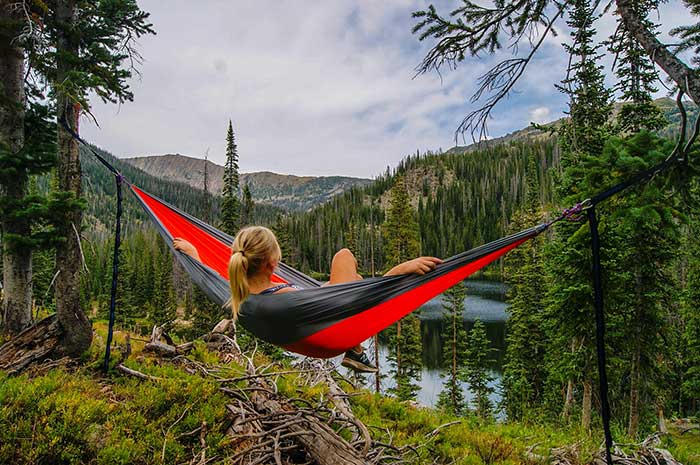
- Base Weight: The weight of a backpack without consumables like food, water, and fuel.
- Down Sleeping Bag: A lightweight sleeping bag insulated with down feathers for warmth.
- Expedition Ultralight: Applying ultralight principles to extended trips and challenging conditions.
- Frameless Pack: A backpack without a rigid frame, focusing on minimalism and weight reduction.
- Gram Weenies: Enthusiasts obsessed with shaving off every gram of weight from their gear.
- Hiking Pole Tent: A minimalist shelter supported by hiking poles, eliminating the need for tent poles.
- Ultralight insulated Pad: A lightweight sleeping pad with added insulation for colder conditions.
- Knotless Tarp Pitch: Setting up a tarp without using knots, using hardware or techniques like hitches.
- Lightweight Stove: A compact and efficient stove designed for minimal fuel consumption.
- Minimalist Footprint: Reducing gear to the bare essentials without compromising safety or comfort.
- Nero: A day of very low mileage on a thru-hike, often spent in camp or a nearby town.
- Overnighter: A short, one-night backpacking trip to test gear and enjoy nature.
- Pared-Down Gear: Streamlining gear choices by selecting versatile, multi-use items.
- Quick-Dry Clothing: Clothing designed to wick moisture away and dry rapidly.
- Rain Skirt: A lightweight garment worn around the waist to protect against rain while hiking.
- Silnylon: A lightweight and durable fabric commonly used for tents and tarps.
- Trail Runners: Lightweight, low-cut hiking shoes suitable for fast-paced hiking and running.
- Ultralight Tarp: A minimalist shelter option made of lightweight, waterproof fabric.
Glamping/Glam Camping Terminology
- Airstream Trailer: A classic, streamlined aluminum trailer known for its luxurious interiors.
- Bell Tent: A spacious, canvas tent with a bell-like shape, often used for upscale camping.
- Canvas Cabin: A large, sturdy canvas tent designed to accommodate groups or families.
- Decked-Out Campsite: A campsite equipped with lavish amenities, furniture, and decorations.
- En Suite Bathroom: A private bathroom facility attached to a glamping accommodation.
- Fire Pit Lounge: A cozy outdoor seating area with a fire pit as a focal point.
- Glamorous Airstream: A luxurious version of the iconic Airstream trailer, featuring high-end furnishings.
- Hot Tub Haven: A glamping site featuring a private hot tub for relaxation.
- In-Tent Heating: Providing heating systems inside tents for comfort during cooler seasons.
- Jacuzzi Yurt: A yurt-style accommodation with an attached Jacuzzi for a touch of luxury.
- Kingsize Bed: Oversized beds with premium mattresses for maximum comfort.
- Luxury Safari Tent: A high-end canvas tent designed for comfort and style.
- Majestic Views: Glamping locations situated in stunning natural landscapes.
- Nature-Inspired Decor: Interior design elements that incorporate natural materials and themes.
- Outdoor Lounge Area: Comfortable seating arrangements in an outdoor space.
- Plush Furnishings: High-quality, comfortable furniture and furnishings.
- Quaint Cabin: A charming, well-appointed cabin with rustic appeal.
- Romantic Canopy Bed: A four-poster bed with draped fabric for a romantic ambiance.
- Spa Retreat: Glamping accommodations featuring on-site spa services.
- Treetop Suite: Elevated accommodations nestled in the treetops for a unique experience.
Overlanding Terminology
- Overlanding: Traveling long distances in a self-sufficient vehicle, often through challenging terrain. One can say it is a hybrid of off-roading, remote traveling, and camping.
- 4×4 Vehicle: A vehicle equipped with four-wheel drive, essential for off-road and overlanding adventures.
- Bush Mechanics: Creative and resourceful vehicle repairs using available tools and materials.
- Camping Fridge: A portable refrigerator/freezer for preserving food and beverages during extended trips.
- Diff Lock: A differential lock that improves traction by linking both wheels on an axle.
- Expedition Vehicle: A specially outfitted vehicle designed for long-distance travel and self-sufficiency.
- Fuel Range: The distance a vehicle can travel on a full tank of fuel, crucial for remote travel.
- Ground Clearance: The distance between the lowest point of a vehicle and the ground, essential for off-roading.
- High-Lift Jack: A versatile tool for lifting vehicles, changing tires, and other maintenance tasks.
- In-Cab Communications: Radios or communication systems for staying connected in remote areas.
- Jerrycan: A portable container for carrying extra fuel, water, or other liquids.
- Kinetic Recovery Rope: A specialized rope used for vehicle recovery, designed to stretch and absorb energy.
- Lift Kit: Modifications to a vehicle’s suspension system to increase ground clearance.
- Mud Terrain Tires: Aggressive tires designed for off-road and muddy conditions.
- Nomadic Lifestyle: Embracing a mobile and self-sufficient way of life while traveling.
- Off-Grid Camping: Camping without access to traditional utilities and facilities.
- Roof Rack: A framework mounted on a vehicle’s roof to carry gear and equipment.
- Skid Plate: A protective plate covering the undercarriage of a vehicle to shield against rocks and debris.
- Traction Boards: Rigid boards used for enhancing traction when a vehicle gets stuck.
- UHF Radio: A type of two-way radio commonly used for communication in remote areas.
Backyard Camping Terminology
- Blanket Fort: A makeshift shelter created using blankets and furniture.
- Crickets Chirping: The soothing sound of crickets at night, creating a natural ambiance.
- Fire Pit Gathering: A social gathering around a backyard fire pit for storytelling and relaxation.
- Glow Sticks: Illuminating sticks used to create a colorful and ambient atmosphere for some fun backyard camping.
- Homemade Lantern: A DIY light source made from a jar or container and a candle, appropriate for backyard camping.
- Insect Netting: Mesh screens or netting to keep insects out of tents or sleeping areas.
- Jumping in Sleeping Bags: Fun and playful activity inside sleeping bags.
- Kiddie Pool Bath: Using a small pool for a refreshing dip or bath during backyard camping.
- Leaf Rubbing: Creating art by placing leaves under paper and gently rubbing them with crayons.
- Nature Sounds: Enjoying the rustling of leaves, wind, and other outdoor sounds.
- Outdoor Movie Night: Watching movies projected outdoors with a portable screen.
- Pillow Pile: Arranging pillows and cushions for a comfortable seating or lounging area.
- Quiet Reflection: Taking time to relax, meditate, or journal in a peaceful setting.
- Scavenger Hunt: A backyard version, searching for hidden items or natural treasures.
- Tree Swing: A swing attached to a tree branch for playful enjoyment.
- Unplugged Time: Disconnecting from screens and electronics to fully embrace nature.
- Vegetable Garden Tour: Exploring the backyard garden and learning about plants.
- Wildlife Observation: Identifying and appreciating local birds, insects, and animals.
- Xylophone Music: Playing outdoor musical instruments, like xylophones or chimes.
- Yoga in Nature: Practicing yoga poses and stretches amidst the outdoor surroundings.
Winter Camping Terminology
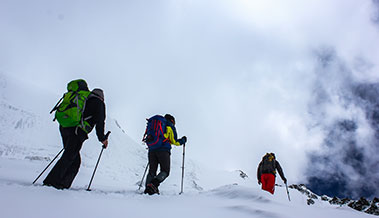
- Avalanche Beacon: A device used for locating buried individuals in snow during avalanches.
- Balaclava: A head cover that protects the face and neck from cold weather.
- Cold Weather Tent: A specialized tent designed to withstand harsh winter conditions.
- Down Jacket: A warm, insulated jacket filled with down feathers for insulation.
- Expedition Mittens: Heavy-duty, insulated mittens designed for extreme cold.
- Frostbite: Tissue damage caused by freezing, often affecting extremities like fingers and toes.
- Gaiters: Protective coverings worn over boots to prevent snow and debris from entering.
- Hypothermia: A potentially dangerous drop in body temperature due to prolonged exposure to cold.
- Ice Axe: A tool used for ice climbing, self-arrest, and other winter mountaineering tasks.
- Katabatic Wind: Cold, dense wind that flows downhill, often encountered in mountainous regions.
- Layering System: Wearing multiple clothing layers to regulate body temperature in changing conditions.
- Mountaineering: Climbing mountains and navigating icy and snowy terrain.
- Nordic Skiing: Cross-country skiing on flat or gently rolling terrain.
- Overnight Snow Shelter: Building a shelter from snow, such as a snow cave or quinzee.
- Pulk: A sled used for hauling gear over snow during winter expeditions.
- Quick Melt: Rapid melting of snow due to rising temperatures or direct sunlight.
- Rime Ice: Ice that forms on surfaces due to freezing fog or mist.
- Snowshoes: Footwear with large frames used to distribute weight and prevent sinking in snow.
- Thermal Blanket: Reflective blanket used to retain body heat and provide insulation.
Tarp Camping Terminology
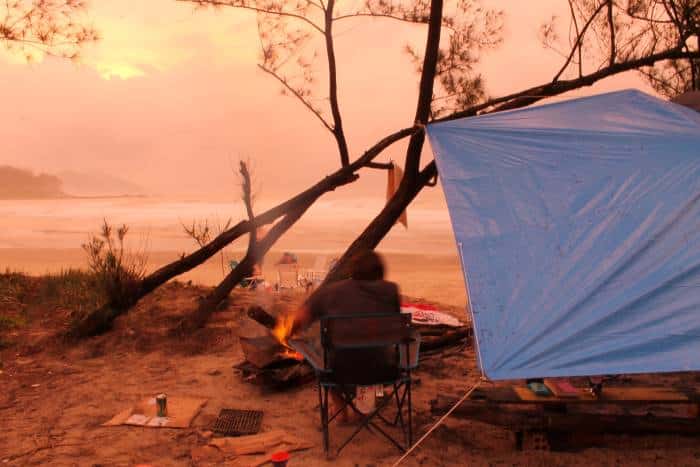
- A-Frame Pitch: A tarp setup resembling the letter “A” for effective rain and wind protection.
- Elevated Tarp: A tarp pitched above ground for ventilation and critter avoidance.
Bivvy Sack Terminology
- Aluminized: Bivvy sack material with a reflective layer to retain body heat.
- Breathability: The ability of a bivvy sack to allow moisture vapor to escape.
- Draw Cord: A drawstring closure system to secure the bivvy sack around the user.
- DWR (Durable Water Repellent): A coating that enhances water resistance on the sack’s surface.
- Emergency Shelter: A bivvy sack used as a last-resort shelter during unexpected situations.
- Foot Vent: An opening at the bottom of the bivvy sack for ventilation and moisture release.
- Gore-Tex: A highly breathable and waterproof fabric used in premium bivvy sacks.
- Hypothermia Prevention: Using a bivvy sack to retain body heat and prevent hypothermia.
- Bivvy Sack Insect Protection: Bivvy sacks with mesh panels to keep insects out while maintaining airflow.
- Jacket Integration: Wearing a bivvy sack over a jacket for additional warmth and insulation.
Lazy Camping Terminology
- Air Lounger: An inflatable, portable chair for relaxed seating at the campsite.
- Barefoot Camping: Camping without wearing shoes to connect with nature.
- Campfire Chat: Engaging in leisurely conversations around the campfire.
- Day Hammock: A lightweight hammock for lounging during lazy afternoons.
- Eazy Chair: A folding chair designed for comfort and relaxation.
- Freeform Exploration: Roaming and exploring the campsite without a specific agenda.
- Hammock Napping: Taking a restful nap in a hammock during lazy hours.
- Idle Observing: Simply sitting and observing the surroundings, embracing the moment.
- Lazy Cooking: Preparing simple and quick meals with minimal effort.
- Mellow Music: Playing soothing tunes to create a relaxed camping atmosphere.
Canoe/Kayak Camping Terminology
- Anchor Trolley: A system that allows you to adjust the position of an anchor from your kayak or canoe.
- Bow: The front end of a canoe or kayak.
- Current: The flow of water in a river or stream.
- Dry Bag: A waterproof bag used to keep gear and belongings dry while paddling.
- Eddy: A calm area of water near the shore, often behind rocks or obstacles.
- Ferrying: Crossing a river or stream diagonally to navigate through the current.
- Gunwales: The upper edges of a canoe or kayak where the sides meet the deck.
- Hatch: A watertight compartment on a kayak for storing gear.
- Inflatable Kayak: A kayak that can be inflated and deflated for easy transport and storage.
- J-Stroke: A paddling technique used to keep a canoe or kayak on a straight course.
Primitive Camping Terminology
- Bivouac: A temporary campsite with minimal equipment and shelter.
- Campfire Cooking: Preparing meals over an open fire using basic utensils.
- Dugout Shelter: A shelter created by digging a depression in the ground and covering it.
- Gatherer-Hunter Style: Embracing a lifestyle that involves foraging and hunting for sustenance.
- Handmade Tools: Crafting tools and utensils from natural materials found in the environment.
- Indigenous Techniques: Traditional methods of survival and camping used by native communities.
- Lean-To Shelter: A simple shelter constructed using a slanted roof supported by poles.
- Natural Navigation: Navigating using natural landmarks like the sun, stars, and terrain.
- Primitive Fire Making: Creating fire using friction methods, such as the bow drill or hand drill.
Dispersed Camping Terminology
- Backcountry Campsite: A remote campsite located away from developed areas.
- Campfire Permit: Authorization required for campfires in certain dispersed camping areas.
- Dispersed Camping Area: Designated areas where camping is allowed outside of established campgrounds.
- Ecological Impact: The influence of camping on the natural environment and ecosystems.
- Fire Pan: A portable container used to contain and manage campfire ash.
- GPS Coordinates: Geographic coordinates used to locate dispersed camping sites accurately.
- Minimal Impact Camping: Techniques to reduce the ecological footprint while camping.Nah
- Off-Trail Camping: Setting up camp away from established trails and paths.
Motorcycle Camping Terminology
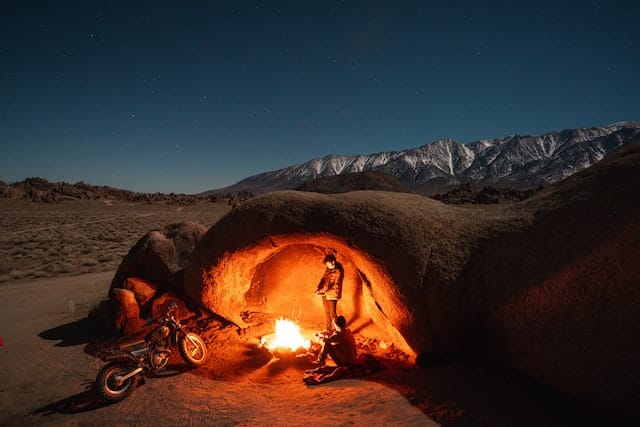
- Saddlebags: Bags attached to the sides of a motorcycle, used to carry camping gear and essentials.
- Tank Bag: A bag mounted on the motorcycle’s fuel tank, providing easy access to maps, documents, and small items.
- Kickstand Plate: A flat plate placed under the kickstand to prevent it from sinking into soft ground at the campsite.
- Camping Hammock: A lightweight and compact hammock designed for motorcycle campers to sleep comfortably.
- Portable Camp Stove: A compact stove that can be carried on a motorcycle for cooking meals at the campsite.
- Compression Sacks: Bags used to compress clothing and sleeping bags, maximizing space in saddlebags.
- Bungee Cords: Elastic cords with hooks used to secure gear and equipment on the motorcycle.
- Tent Footprint: A groundsheet placed under the tent to protect it from abrasion and moisture.
- Tool Roll: A compact roll-up pouch for carrying essential tools and maintenance equipment.
- Moto-Camping Group: A community of motorcycle enthusiasts who share tips, routes, and experiences related to camping trips.
Cabin Camping Terminology
- A-Frame Cabin: A cabin with a steep, triangular roof resembling the letter “A.”
- Cabin Kit: Pre-cut materials and components for DIY cabin construction.
- Decking: An elevated platform attached to the cabin, often used for outdoor seating.
- Fireplace Insert: A stove or device designed to fit into a cabin’s existing fireplace for heating.
- Gable Roof: A traditional pitched roof design with two sloping sides.
- Hot Tub Cabin: A cabin featuring a private outdoor hot tub for relaxation.
- Loft: An elevated space within the cabin used for additional sleeping or storage.
- Porch Swing: A suspended bench on the cabin’s porch, offering a relaxing spot to sit.
- Rustic Decor: Furnishings and design elements that evoke a natural, outdoor ambiance.
- Treehouse Cabin: A treehouse cabin is a rustic or luxury accommodation built among trees, often elevated off the ground. It offers a unique and immersive camping experience, allowing guests to stay in a cozy cabin nestled within the natural surroundings of a forest or wooded area.
- Treehouse Cabin Camping: Treehouse cabin camping combines the charm of traditional camping with the comfort of a cabin stay. Campers can enjoy the adventure of sleeping in an elevated treehouse cabin, surrounded by nature, while still having amenities like beds, heating, and sometimes even kitchen facilities for a memorable and magical camping experience.
- Treehouse Ladder: A secure ladder or staircase used to access a treehouse cabin, ensuring safe entry and exit from the elevated structure.
General Camping Terminology
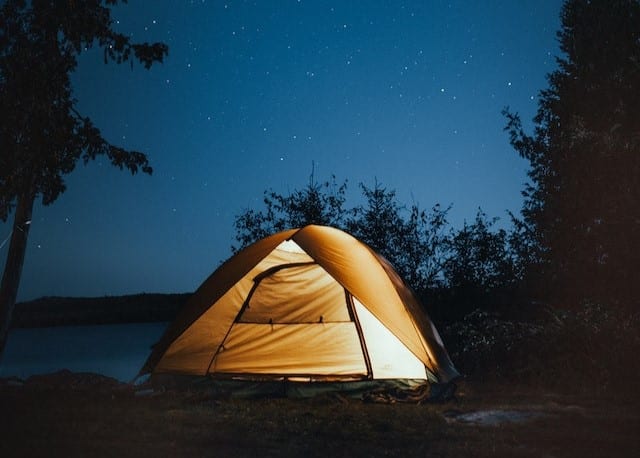
- Bear Hang: Suspending food and scented items from a tree to deter bears and other wildlife.
- Bear Canister: A portable container used to store food and scented items, minimizing interactions with bears and wildlife.
- Bug Repellent: Substances used to deter insects and pests from bothering campers.
- Campfire Ring: A circular enclosure made of stone or metal where campfires can be safely contained.
- Camping Etiquette: Unspoken rules and behaviors that promote a positive camping experience for all.
- Emergency Whistle: A loud whistle used to signal for help in case of emergencies.
- Firewood: Wood collected or purchased for use as fuel in campfires.
- Gorp: An acronym for “Good Old Raisins and Peanuts,” referring to trail mix.
- Hiking Boots: Sturdy footwear designed to provide support and grip for hiking trails.
- Insect Screen: Mesh material used to create barriers against insects in tents and shelters.
- Jambalaya: A one-pot dish made with meat, vegetables, and rice, often prepared while camping.
- Knot-Tying: Learning various knots for securing gear, setting up shelters, and other outdoor tasks.
- Leave No Trace: Ethical outdoor principles guiding hikers to minimize their impact on the environment.
- LNT Principles: The Leave No Trace guidelines for minimizing environmental impact while hiking or camping.
- Marshmallow Roasting Stick: A long stick used to roast marshmallows over a campfire.
- Nylon Cord: Durable and lightweight cordage used for various camping applications.
- Outhouse: A simple outdoor toilet facility often found in remote camping areas.
- Portable Water Filter: A device used to purify natural water sources for safe consumption.
- Rain Gear: Waterproof clothing, including jackets and pants, to protect against rain and wind.
- Sleep System: The combination of sleeping bag, sleeping pad, and any additional layers for a comfortable night’s rest.
- Water Filtration System: Equipment used to remove impurities and contaminants from natural water sources, ensuring safe and clean drinking water during camping.
- Zero-Degree Sleeping Bag: A sleeping bag designed for sub-freezing temperatures, providing essential warmth during cold nights.
Conclusion
There you have it – a handful of camping terms, and then some.
You can keep coming back to this page to search for terms you are wondering about, print it all out, or read it through to educate yourself. Remember to bookmark!
Now, you probably came here because you’re considering camping of some sort. Why don’t you check out the pros and cons of backpacking with a hammock next, You’ll probably be hanging out on your next adventure in no time.
Did you miss anything on my list? Leave a comment below!
Sources:
https://www.merriam-webster.com/vocabulary/camping-words-vocabulary-list
https://dictionary.cambridge.org/dictionary/
Simon, the founder of HappyHammockCamper, is a passionate hammock camping enthusiast who discovered the joys of this unique camping style a few years ago. Through HappyHammockCamper, he shares his knowledge and experience in hammock camping, gear and camping tips.

